The Flames of Paris, Bolshoi Ballet, Royal Opera House | reviews, news & interviews
The Flames of Paris, Bolshoi Ballet, Royal Opera House
The Flames of Paris, Bolshoi Ballet, Royal Opera House
The Moscow company saves its truest and most brilliant for last
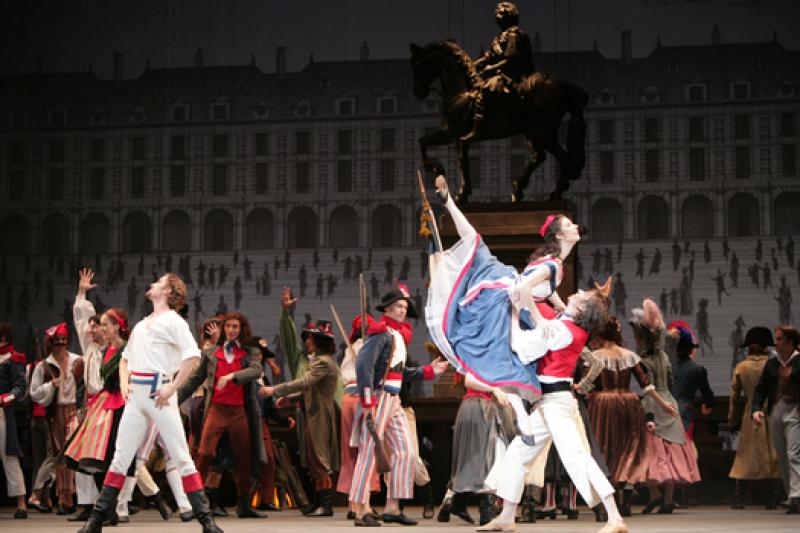
The Bolshoi left it till last to be most itself, to dance a ballet that is truly of its blood, its seed - its closing on Alexei Ratmansky's The Flames of Paris will leave much happiness in the memory to override the problematic productions of classics, the unidiomatic Balanchine and the awful backstage events.
The previous night the visiting stars Natalia Osipova and Ivan Vasiliev had raised the roof; for the final performance Vasiliev was there again, but this time with Ekaterina Krysanova, the redhead whose Sleeping Beauty had been so charming, replacing the original Maria Alexandrova (pictured above and below, regrettably injured early in the tour). Without the blinding effect of the Vasipova razzle-dazzle the entire cast could come into focus, and some tremendous performances and company cohesion could be enjoyed. This, like Osipova and Vasiliev, is Ratmansky's generation of dancers.
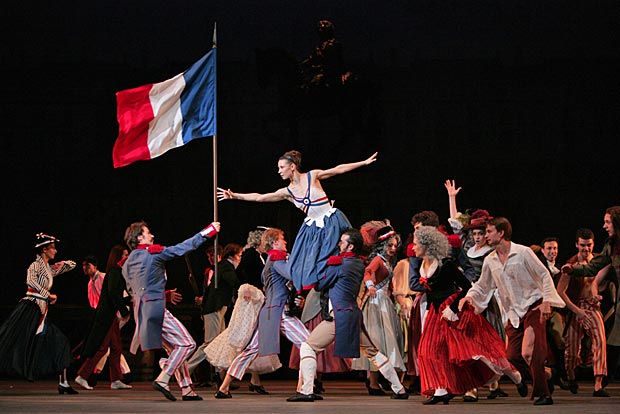 The Flames of Paris, despite its French Revolution theme, has Moscow written through it. This 2008 version has travelled a long way from the original Soviet creation of 1932, starring Galina Ulanova who confessed herself utterly bewildered by her role as the actress Mireille de Poitiers. But then the original stars were not individuals but the glorious forces of the Bolshevik revolution. Vasily Vainonen’s vibrantly rhythmic ensemble dances were what whipped up the packed audiences and Josef Stalin himself, but the story insisted on a muddled whirl of characters - Cyril Beaumont’s synopsis of it covered eight pages.
The Flames of Paris, despite its French Revolution theme, has Moscow written through it. This 2008 version has travelled a long way from the original Soviet creation of 1932, starring Galina Ulanova who confessed herself utterly bewildered by her role as the actress Mireille de Poitiers. But then the original stars were not individuals but the glorious forces of the Bolshevik revolution. Vasily Vainonen’s vibrantly rhythmic ensemble dances were what whipped up the packed audiences and Josef Stalin himself, but the story insisted on a muddled whirl of characters - Cyril Beaumont’s synopsis of it covered eight pages.
Ratmansky took enormous liberties with it when, as the embattled but farsighted artistic director of the Bolshoi from 2004 to 2008, he decided to rediscover this Communist totem and renew it as ballet theatre for the new generations of Bolshoi dancers and audiences. He’s retained the flamboyant setpieces of Vainonen’s but added love interest; more courageously, he invented a new narrative momentum that ends with an ominousness that wasn’t there in the original upbeat work that so pleased Stalin.
From this plait of stories emerges not just a lively human momentum inside the grand doings, but a palimpsest of ballet and history
True, it takes a little while in the opening scene to realise that the individual young people will cohere in two sets of lovers, linked by brother and sister Jérôme and Jeanne. Once they’re in place we can suffer and cheer with them in a contemporary-feeling narrative where Vainonen’s popular dances can sparkle and thrill. The added bonus is that this more layered scenario by Ratmansky and his colleague Alexander Belinsky works so well with Boris Asafiev’s jolly score, which expertly amasses baroque musical styles that tell their own fun time-warp story.
Now the original heroine Mireille de Poitiers complements the young people’s emotional narrative with her own malleable symbolism, as a gorgeous theatrical actress who can be hired to embody this or that metaphor, whoever pays her.
From this plait of stories emerges not just a lively human momentum inside the grand doings, but a thought-provoking palimpsest of ballet and history, the myths taken from baroque and Soviet times as well as the 18th century - a many-stranded sparky mixture of the art of the Bolshoi, athletic, satirical, fresh.
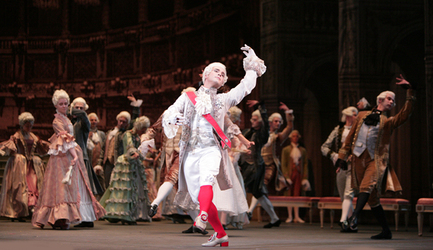 The first scene takes a while to get going and set up the characters, but one's soon conquered by the fierce energy of the street dances. The switch to the pomp and gold-plating of the court scene (pictured right) is a blinder, with dazzling dresses, plumes and wigs shinily lit, amid which brightness Ratmansky’s fatigued courtiers offer the Bolshoi dancers much performing fun. King Louis XVI insists, amid the old-school gavottes, on showing his new pet dance: a contorted peasant stomp that’s almost a dance equivalent of “let them eat cake”, his wife’s famous put-down.
The first scene takes a while to get going and set up the characters, but one's soon conquered by the fierce energy of the street dances. The switch to the pomp and gold-plating of the court scene (pictured right) is a blinder, with dazzling dresses, plumes and wigs shinily lit, amid which brightness Ratmansky’s fatigued courtiers offer the Bolshoi dancers much performing fun. King Louis XVI insists, amid the old-school gavottes, on showing his new pet dance: a contorted peasant stomp that’s almost a dance equivalent of “let them eat cake”, his wife’s famous put-down.
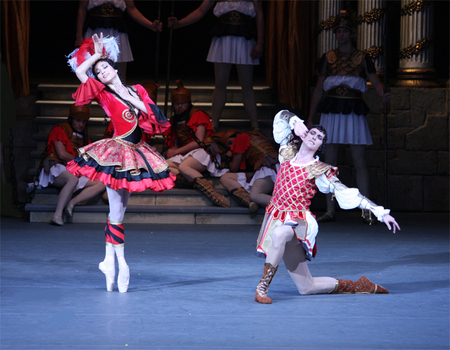 Then we slide into another time-layer, into the allegorical divertissement that is being shown to the court, performed by the famous Parisian thespians, Mireille de Poitiers and Antoine Mistral (pictured, Ekaterina Shipulina and Vladimir Neporozhny, © Elena Fetisova).
Then we slide into another time-layer, into the allegorical divertissement that is being shown to the court, performed by the famous Parisian thespians, Mireille de Poitiers and Antoine Mistral (pictured, Ekaterina Shipulina and Vladimir Neporozhny, © Elena Fetisova).
On the page this seems all too much to take in, and early Bolshoi performances drew its humorousness too ponderously. But with this set of performers the scene sprang mockingly to life, a very merry entertainment.
Hail Kristina Kretova, a Mireille de Poitiers of utmost glamour and wit, a thesp to her fingertips. In their Armida and Rinaldo ballet, she and the treasurably spineless Artem Ovcharenko gauged the balance of parody and truth to perfection. Kretova was memorably amusing trying ineptly to whip up her witch’s cauldron (“Hey, I’m a goddess, not a stagehand”), coughing when the smoke finally appears. In the final scene, she switched immaculately to embodying the totemic Marianne of the revolutionaries. It was joyously rich acting and comedic sense, coupled with the nuanced dancing accomplishment we saw from her Princess Florine in the Sleeping Beauty. Kretova is a prize girl, and so was the fluttering Chinara Alizade as Amour. This kind of natural stagecraft and deft character-playing is the Bolshoi’s personality (and makes you see why Frederick Ashton fits in in Moscow - some of the playing could come from The Dream).
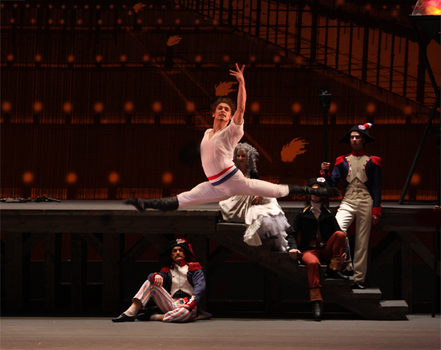
Ivan Vasiliev as Philippe (pictured above by Elena Fetisova) once again makes one laugh with wonder at his joie de vivre, his exultant enjoyment of his job, flying about the stage at improbable altitude milking the audience winningly; and Krysanova, if not the lightning force that Osipova is, produced fizzing technical excitement to accompany her gentler interpretation.
Denis Savin’s Jérôme was a boyish figure of utmost sincerity, crushed by the death of his aristocratic love, the beauteous Anna Rebetskaya. As her father the Marquis I can’t imagine better than Ruslan Skvortsov, whose dark wuthering brows and jutting chin perfectly complement the white periwig, but who also knows how to walk a villain's walk with sexually interesting menace. Praise also to Denis Medvedev’s Louis XVI, the Marseillaise trio of men led by Igor Tsvirko, and the entertaining Alexei Loparevich (previously a splendid Carabosse) as MC.
This was the real Bolshoi, not disguising, not pretending, being its vivid, conquering self. Till we meet again.
Watch Vasiliev, Osipova and Denis Savin lead the thrilling Vainonen Basque Dance in the Bolshoi's DVD of The Flames of Paris
rating
Share this article
The future of Arts Journalism
You can stop theartsdesk.com closing!
We urgently need financing to survive. Our fundraising drive has thus far raised £49,000 but we need to reach £100,000 or we will be forced to close. Please contribute here: https://gofund.me/c3f6033d
And if you can forward this information to anyone who might assist, we’d be grateful.

Subscribe to theartsdesk.com
Thank you for continuing to read our work on theartsdesk.com. For unlimited access to every article in its entirety, including our archive of more than 15,000 pieces, we're asking for £5 per month or £40 per year. We feel it's a very good deal, and hope you do too.
To take a subscription now simply click here.
And if you're looking for that extra gift for a friend or family member, why not treat them to a theartsdesk.com gift subscription?
more Dance
 'We are bowled over!' Thank you for your messages of love and support
Much-appreciated words of commendation from readers and the cultural community
'We are bowled over!' Thank you for your messages of love and support
Much-appreciated words of commendation from readers and the cultural community
 R:Evolution, English National Ballet, Sadler's Wells review - a vibrant survey of ballet in four acts
ENB set the bar high with this mixed bill, but they meet its challenges thrillingly
R:Evolution, English National Ballet, Sadler's Wells review - a vibrant survey of ballet in four acts
ENB set the bar high with this mixed bill, but they meet its challenges thrillingly
 Like Water for Chocolate, Royal Ballet review - splendid dancing and sets, but there's too much plot
Christopher Wheeldon's version looks great but is too muddling to connect with fully
Like Water for Chocolate, Royal Ballet review - splendid dancing and sets, but there's too much plot
Christopher Wheeldon's version looks great but is too muddling to connect with fully
 iD-Reloaded, Cirque Éloize, Marlowe Theatre, Canterbury review - attitude, energy and invention
A riotous blend of urban dance music, hip hop and contemporary circus
iD-Reloaded, Cirque Éloize, Marlowe Theatre, Canterbury review - attitude, energy and invention
A riotous blend of urban dance music, hip hop and contemporary circus
 How to be a Dancer in 72,000 Easy Lessons, Teaċ Daṁsa review - a riveting account of a life in dance
Michael Keegan-Dolan's unique hybrid of physical theatre and comic monologue
How to be a Dancer in 72,000 Easy Lessons, Teaċ Daṁsa review - a riveting account of a life in dance
Michael Keegan-Dolan's unique hybrid of physical theatre and comic monologue
 A Single Man, Linbury Theatre review - an anatomy of melancholy, with breaks in the clouds
Ed Watson and Jonathan Goddard are extraordinary in Jonathan Watkins' dance theatre adaptation of Isherwood's novel
A Single Man, Linbury Theatre review - an anatomy of melancholy, with breaks in the clouds
Ed Watson and Jonathan Goddard are extraordinary in Jonathan Watkins' dance theatre adaptation of Isherwood's novel
 Peaky Blinders: The Redemption of Thomas Shelby, Rambert, Sadler's Wells review - exciting dancing, if you can see it
Six TV series reduced to 100 minutes' dance time doesn't quite compute
Peaky Blinders: The Redemption of Thomas Shelby, Rambert, Sadler's Wells review - exciting dancing, if you can see it
Six TV series reduced to 100 minutes' dance time doesn't quite compute
 Giselle, National Ballet of Japan review - return of a classic, refreshed and impeccably danced
First visit by Miyako Yoshida's company leaves you wanting more
Giselle, National Ballet of Japan review - return of a classic, refreshed and impeccably danced
First visit by Miyako Yoshida's company leaves you wanting more
 Quadrophenia, Sadler's Wells review - missed opportunity to give new stage life to a Who classic
The brilliant cast need a tighter score and a stronger narrative
Quadrophenia, Sadler's Wells review - missed opportunity to give new stage life to a Who classic
The brilliant cast need a tighter score and a stronger narrative
 The Midnight Bell, Sadler's Wells review - a first reprise for one of Matthew Bourne's most compelling shows to date
The after-hours lives of the sad and lonely are drawn with compassion, originality and skill
The Midnight Bell, Sadler's Wells review - a first reprise for one of Matthew Bourne's most compelling shows to date
The after-hours lives of the sad and lonely are drawn with compassion, originality and skill
 Ballet to Broadway: Wheeldon Works, Royal Ballet review - the impressive range and reach of Christopher Wheeldon's craft
The title says it: as dancemaker, as creative magnet, the man clearly works his socks off
Ballet to Broadway: Wheeldon Works, Royal Ballet review - the impressive range and reach of Christopher Wheeldon's craft
The title says it: as dancemaker, as creative magnet, the man clearly works his socks off
 The Forsythe Programme, English National Ballet review - brains, beauty and bravura
Once again the veteran choreographer and maverick William Forsythe raises ENB's game
The Forsythe Programme, English National Ballet review - brains, beauty and bravura
Once again the veteran choreographer and maverick William Forsythe raises ENB's game

Add comment